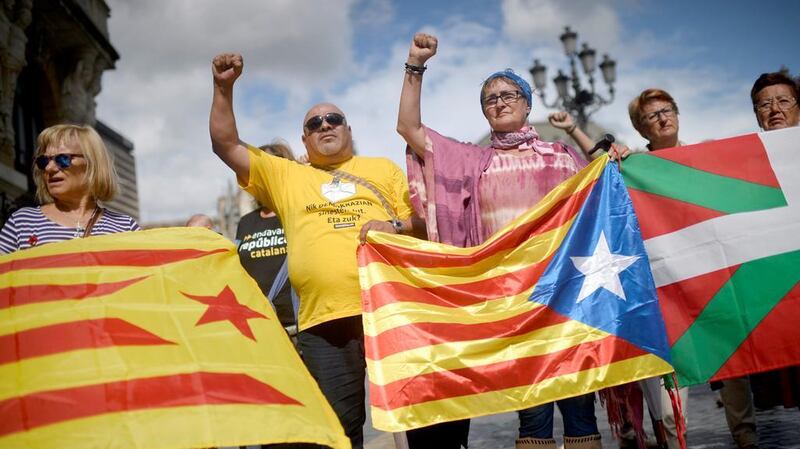On the face of it the referendum is the perfect instrument for a country to resolve major constitutional issues. In recent years such votes have demonstrated the dangers inherent in exercising a blunt, binary device.
This year saw referenda on independence called in Kurdistan and Catalonia, and in both cases the results of the votes led to violence as Iraq and Spain respectively cracked down on the secessionist regions.
The poll called on September 25 by the Kurdistan Regional Government took place against the backdrop of chaos in the Middle East following the rise of ISIL.
When the Iraqi military shattered in the face of ISIL’s advance in 2014, it was the Kurdish peshmerga forces who stepped into the vacuum and took control of strategically important cities such as Kirkuk.
Kurdish leaders agreed to put the goal of independence on hold until the fight against ISIL was won.
The ruling political parties of Iraqi Kurdistan, the KDP and PUK, agreed to push for a referendum in the second half of 2017 following the recapture of Mosul but against a backdrop of increasing disunity between the major factions, the vote was held and returned, by 93% to 7%, on a turnout of more than seven-tenths of the electorate.
_______________
Read more:
[ 92% of Kurdish voters choose independence from Iraq ]
[ Iraq president calls for direct talks between Baghdad and Erbil ]
[ Thousands flee Kirkuk amid fear of war ]
[ What Kurdistan can learn about secession from Spain ]
_______________
Baghdad immediately assembled forces to take back the mixed city of Kirkuk, where the Kurds had been specifically warned not to hold the poll.
Despite back-channel attempts to resolve the crisis peacefully, in the end more than 80 people died as the army resumed control of the city against minimal resistance.
The political aftermath of the referendum has been tense, with the Iraqi Kurd president Masoud Barzani standing down in November and calls for constitutional talks between the region and the central government not coming to fruition.
The Catalonian desire for self-rule has a similarly long-term background; the region has a distinct history stretching back for hundreds of years, and until the Spanish Civil War in the 1930s it was allowed a degree of autonomy in how it ran it affairs.
General Francisco Franco’s Nationalists crushed the Republicans who had made Barcelona their capital. Catalan autonomy was abolished during Franco’s dictatorship from 1939-75.
After democracy was reintroduced to Spain by the 1978 constitution, the Catalans were again granted autonomy, which was increased in a 2006 statute. The wealthy region subsequently lost most of these gains four years later due to a constitutional court ruling and during the long recession that affected the nation as a whole, resentment towards central government in Madrid increased.
Once a separatist administration was in place in Barcelona after regional elections in 2015, it soon became clear that a flashpoint would come – and so it proved, as momentum grew for a referendum asking the question: “Do you want Catalonia to become an independent state in the form of a republic?” which was eventually called this year for October 1.
The national government and constitutional courts called the poll illegal and on the day of voting riot police sent by Madrid cracked down violently on the streets of Catalonia, with more than 1,000 people being injured as they tried to vote. The result was 92% to 8% in favour of independence, but on a turnout of just 42% as unionists in the region had boycotted the poll.
On October 27, the regional government declared independence and within hours the Spanish government had imposed direct rule on Catalonia.
Catalan president Carles Puigdemont fled to Brussels with members of his cabinet, with those who returned to Spain being arrested. Regional elections have been called by Madrid for December 21 which polls suggest will return a minority separatist coalition.
_______________
Read more:
[ Separatist leader makes final plea for split with Spain ]
[ Catalonian referendum to have lasting implications for Spanish economy ]
[ Catalonia referendum - 90% voted for independence, officials say, with 844 casualties claimed ]
_______________
For a country that prides itself on the conservatism of its political traditions, it’s ironic that the United Kingdom has staged two recent referendum votes, which have been highly disruptive. Britain’s recent experiments with plebiscites almost led to the dissolution of the 310-year bond between Scotland and the rest of the country in 2014, and did actually see the country vote to leave the European Union after 43 years.
The first poll, on Scottish independence, was the greatest threat to the union since it was sealed in 1707. While there had always been voices in favour of various versions of home rule, the movement was always more concerned with achieving devolution of certain powers to Edinburgh rather than full independence.
With the discovery of natural resources off the Scottish coast in the North Sea during the 1970s heightening a national sense of injustice about where the money for ‘their oil’ was going, the push for home rule forced the Labour government of prime minister James Callaghan to offer a referendum in 1979 on whether to have a devolved Scottish assembly. A majority voted in favour, but turnout was too low to effect the change.
The nationalist movement grew during 18 years of Tory government, and when Labour returned to government in 1997, they established the new Scottish parliament.
However, rather than stoppering the nationalist genie in the lamp, the independence movement grew stronger, all the more so after the Scottish Nationalist Party (SNP) became the largest party in the regional assembly in 2007.
The eventual margin of victory for the unionists was wider than many expected, with a 55-45% split on an incredible turnout – for Britain – of 85%. The question remains when not if another vote will be held.
For most of the four-and-a-bit decades of its membership of the EU, Britain had been at best a reluctant member of the trading bloc, with significant factions in both major parties finding ideological and constitutional reasons to distrust the union.
Within the Tory party, a strong anti-European movement first sprung to life in the early 1990s, making life a misery for Conservative prime minister John Major. And by the time that the party finally returned to government in 2010, there was a contingent within the parliamentary party which eventually forced David Cameron into holding the June 23 poll – despite him having won an unexpected majority in the 2015 election.
Initially expected by many to be a walkover for the remain side, the polls narrowed as the Leave campaign argued that leaving the EU would result in billions of pounds more for Britain’s totemic National Health Service, and also warned that millions of Turkish immigrants could make their way to the UK if it remained in the union.
The violent rhetoric unleashed during the campaign was blamed for creating the conditions which led to the murder of Labour MP Jo Cox, a remainer, less than a week before the referendum took place. She died at the hands of a far-right terrorist who shouted “Britain first” as he shot her.
The chaos caused by the 52-48 per cent split in favour of leaving continues to ensue; the EU and Britain have only just concluded the first phase of ‘divorce talks’ which have to be concluded before the end of March 2019 when the country will cease to be a member of the union. Interestingly, one of the leading proponents of Britain’s exit and beneficiaries of the Brexit vote, cabinet minister David Davis, once took a different view on the referendum.
“We should not ask people to vote on a blank sheet of paper and tell them to trust us to fill in the details afterwards,” he told the House of Commons in 2002. “Referendums need to be treated as an addition to the parliamentary process, not as a substitute for it.”






